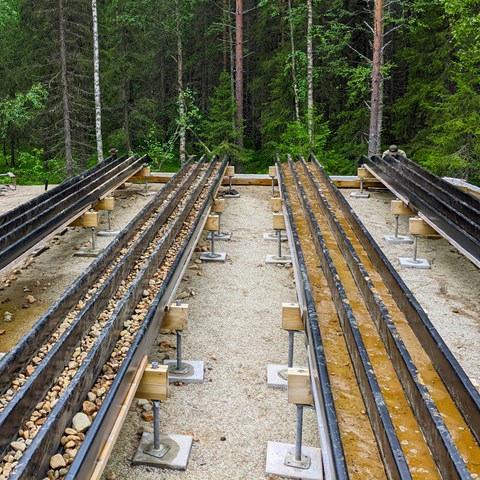Contact
Department of Wildlife, Fish and Environmental Studies
Department of Forest Ecology and Management, Department of Forest Ecology and Management, joint staff

Algae and bacteria offer vital ecosystem functions in our streams. But the Swedish forest is often much too dark to give them an optimal habitat. This is shown in results from an experiment with artificial water channels, where the organisms were given different habitats to colonize in flowing water.
For animals living in our Streams, cyanobacteria and different forms of algae provide a crucial food source, as well as vital eco system functions like regulating carbon dioxide. But for these aquatic biofilms to thrive, the right conditions need to be met. In Swedish forests, where streams run through both dense planted spruce forests and open clear cuts, the light conditions are often extreme.
In a new study from the Swedish university of agricultural science and university of Karlstad, researchers have examined how different light environments and different substrates affect the growth of biofilms, using artificial streams.
In Svartberget experimental area outside Umeå, wooden channels were built, and some of them were shaded, blocking 70 percent of sunlight. They were then filled with sand or rocks, and left with water from a local stream flowing through them for ten weeks.
Only partially through the experiment, clear results began to show. In the channels with a rock based substrate and maximum sun exposure, long strands of green algae had already formed.
“We were almost shocked at the growth rate”, says Maria Myrstener, postdoc at the department of forest ecology and management at SLU. But promoting these fast growing organisms is ultimately not a positive for the ecosystem.
“These stringy green algae grow in warm and sunny conditions, but disappear when fall comes around. Their growth inhibit other organisms, such as diatoms who stay around far longer through the year”.
The green algae did far worse in the shade. The formation of diatoms and to an extent cyanobacteria had occurred in these conditions after ten weeks, but at a far slower rate. The experiment also showed that the substrate had just as big of an impact as the sunlight; in the sand filled channels growth was lower, both in the sunlight and the shade.
The experiment shows that the light environments are sub-optimal for the aquatic biofilm in many forests. At 70 percent shading, production is very low; and the Swedish spruce forest can be darker still.
“There needs to be more variation. The switch between the total absence of shade in clearcuts and almost fully shaded managed forest is not natural, and does not benefit the growth of algae in the streams. In older forests, you can find natural gaps in the riparian zone tree coverage. With more active management in this zone, you could achieve a greater variation“, says Maria Myrstener.
Since the experiment, an additional study with more levels of shade has been completed. The researchers are also studying streams in Västerbotten County so see how different types of riparian forests affect the ecosystem functions, and ultimately hope to improve guidelines on the best possible practices of forest management near streams.
Read the paper:
Experimental riparian forest gaps and increased sediment loads modify stream metabolic patterns and biofilm composition
Författare: Maria Myrstener, Larry A. Greenberg, Lenka Kuglerová
https://doi.org/10.1002/ecs2.4695 (external link)